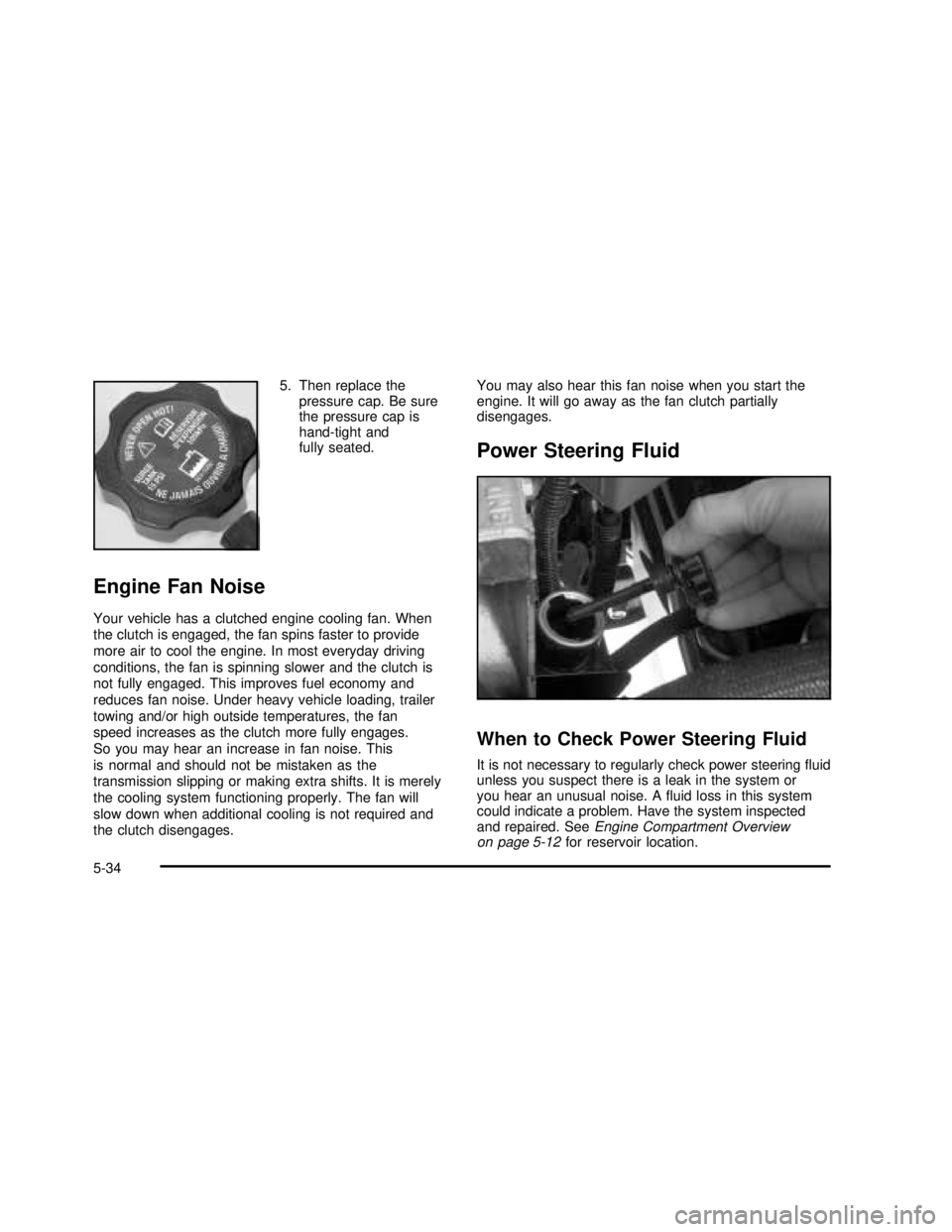Power steering fluid GMC SIERRA 2003 Owner's Manual
[x] Cancel search | Manufacturer: GMC, Model Year: 2003, Model line: SIERRA, Model: GMC SIERRA 2003Pages: 408, PDF Size: 2.58 MB
Page 261 of 408

Service............................................................5-3
Doing Your Own Service Work.........................5-3
Adding Equipment to the Outside of
Your Vehicle..............................................5-4
Fuel................................................................5-4
Gasoline Octane............................................5-4
Gasoline Specifications....................................5-5
California Fuel...............................................5-5
Additives.......................................................5-6
Fuels in Foreign Countries...............................5-6
Filling Your Tank............................................5-7
Filling a Portable Fuel Container.......................5-9
Checking Things Under
the Hood....................................................5-10
Hood Release..............................................5-10
Engine Compartment Overview.......................5-12
Engine Oil...................................................5-13
Engine Air Cleaner/Filter................................5-18
Automatic Transmission Fluid.........................5-20
Engine Coolant.............................................5-23
Coolant Surge Tank Pressure Cap..................5-26
Engine Overheating.......................................5-26
Cooling System............................................5-29Engine Fan Noise.........................................5-34
Power Steering Fluid.....................................5-34
Windshield Washer Fluid................................5-35
Brakes........................................................5-36
Battery........................................................5-39
Jump Starting...............................................5-40
All-Wheel Drive..............................................5-45
Rear Axle.......................................................5-46
Front Axle......................................................5-47
Bulb Replacement..........................................5-48
Halogen Bulbs..............................................5-48
Headlamps..................................................5-48
Front Turn Signal, Sidemarker and
Daytime Running Lamps.............................5-49
Roof Marker Lamps......................................5-51
Center High-Mounted Stoplamp (CHMSL)
and Cargo Lamp.......................................5-52
Pickup Box Identification and Fender
Marker Lamps...........................................5-54
Taillamps.....................................................5-54
Replacement Bulbs.......................................5-55
Windshield Wiper Blade Replacement
..............5-56
Section 5 Service and Appearance Care
5-1
2003 - Sierra Denali
Page 273 of 408

A. Engine Air Cleaner/Filter
B. Coolant Surge Tank
C. Air Cleaner/Filter Restriction Indicator
D. Engine Oil Dipstick
E. Engine Oil Fill Cap
F. Automatic Transmission Dipstick
G. Fan
H. Remote Negative (−) Terminal (GND)
I. Remote Positive (+) Terminal
J. Power Steering Fluid Reservoir
K. Brake Fluid Reservoir
L. Underhood Fuse Block
M. Battery
N. Windshield Washer Fluid Reservoir
Engine Oil
If the CHECK OIL LEVEL light appears on the
instrument cluster, it means you need to check your
engine oil level right away. For more information,
see“CHECK OIL LEVEL”underDIC Warnings and
Messages on page 3-51.
You should check your engine oil level regularly; this is
an added reminder.
Checking Engine Oil
It’s a good idea to check your engine oil every time you
get fuel. In order to get an accurate reading, the oil
must be warm and the vehicle must be on level ground.
The engine oil dipstick has a yellow looped handle and
is located on the passenger’s side of the vehicle.
SeeEngine Compartment Overview on page 5-12for
more information on location.
Turn off the engine and give the oil several minutes to
drain back into the oil pan. If you don’t, the oil
dipstick might not show the actual level.
Pull out the dipstick and clean it with a paper towel or
cloth, then push it back in all the way. Remove it again,
keeping the tip down, and check the level.
5-13
2003 - Sierra Denali
Page 294 of 408

5. Then replace the
pressure cap. Be sure
the pressure cap is
hand-tight and
fully seated.
Engine Fan Noise
Your vehicle has a clutched engine cooling fan. When
the clutch is engaged, the fan spins faster to provide
more air to cool the engine. In most everyday driving
conditions, the fan is spinning slower and the clutch is
not fully engaged. This improves fuel economy and
reduces fan noise. Under heavy vehicle loading, trailer
towing and/or high outside temperatures, the fan
speed increases as the clutch more fully engages.
So you may hear an increase in fan noise. This
is normal and should not be mistaken as the
transmission slipping or making extra shifts. It is merely
the cooling system functioning properly. The fan will
slow down when additional cooling is not required and
the clutch disengages.You may also hear this fan noise when you start the
engine. It will go away as the fan clutch partially
disengages.
Power Steering Fluid
When to Check Power Steering Fluid
It is not necessary to regularly check power steeringfluid
unless you suspect there is a leak in the system or
you hear an unusual noise. Afluid loss in this system
could indicate a problem. Have the system inspected
and repaired. SeeEngine Compartment Overview
on page 5-12for reservoir location.
5-34
2003 - Sierra Denali
Page 295 of 408

How to Check Power Steering Fluid
Turn the key off, let the engine compartment cool down,
wipe the cap and the top of the reservoir clean, then
unscrew the cap and wipe the dipstick with a clean rag.
Replace the cap and completely tighten it. Then remove
the cap again and look at thefluid level on the dipstick.
The level should be at the FULL COLD mark. If
necessary, add only enoughfluid to bring the level up to
the mark.
What to Use
To determine what kind offluid to use, seePart D:
Recommended Fluids and Lubricants on page 6-15.
Always use the properfluid. Failure to use the proper
fluid can cause leaks and damage hoses and seals.
Windshield Washer Fluid
What to Use
When you need windshield washerfluid, be sure to read
the manufacturer’s instructions before use. If you will
be operating your vehicle in an area where the
temperature may fall below freezing, use afluid that has
sufficient protection against freezing. SeeEngine
Compartment Overview on page 5-12for reservoir
location.
Adding Washer Fluid
Open the cap with the
washer symbol on it. Add
washerfluid until the
tank is full.
Notice:
•When using concentrated washerfluid, follow the
manufacturer’s instructions for adding water.
•Don’t mix water with ready-to-use washerfluid.
Water can cause the solution to freeze and
damage your washerfluid tank and other parts of
the washer system. Also, water doesn’t clean as
well as washerfluid.
•Fill your washerfluid tank only three-quarters full
when it’s very cold. This allows for expansion if
freezing occurs, which could damage the tank if
it is completely full.
•Don’t use engine coolant (antifreeze) in your
windshield washer. It can damage your washer
system and paint.
5-35
2003 - Sierra Denali
Page 375 of 408

Transfer Case and Front Axle
(All-Wheel Drive) Inspection
Every 12 months, or at engine oil change intervals,
check front axle and transfer case and add lubricant
when necessary. A�uid loss could indicate a problem.
Check and have it repaired, if needed. Check vent
hose at transfer case for kinks and proper installation.
Brake System Inspection
Inspect the complete system. Inspect brake lines and
hoses for proper hook-up, binding, leaks, cracks,
cha�ng, etc. Inspect disc brake pads for wear and rotors
for surface condition. Inspect other brake parts,
including calipers, parking brake, etc. You may need to
have your brakes inspected more often if your driving
habits or conditions result in frequent braking.
Part D: Recommended Fluids and
Lubricants
Fluids and lubricants identi�ed below by name, part
number or speci�cation may be obtained from your
dealer.
Usage Fluid/Lubricant
Engine OilEngine oil with the American
Petroleum Institute Certi�ed for
Gasoline Engines starburst symbol
of the proper viscosity. To determine
the preferred viscosity for your
vehicle’s engine, seeEngine Oil on
page 5-13.
Engine Coolant50/50 mixture of clean, drinkable
water and use only
DEX-COOL
®Coolant. SeeEngine
Coolant on page 5-23.
Hydraulic Brake
SystemDelco Supreme 11 Brake Fluid or
equivalent DOT-3 brake�uid.
Windshield
Washer SolventGM Optikleen
®Washer Solvent or
equivalent.
Power Steering
SystemGM Power Steering Fluid (GM Part
No. U.S. 1052884, in Canada
993294, or equivalent).
Automatic
TransmissionDEXRON
®-III Automatic
Transmission Fluid.
6-15
2003 - Sierra Denali
Page 391 of 408

A
Accessory Power Outlets.................................3-16
Adding Washer Fluid.......................................5-35
Additional Program Information........................... 7-8
Additives, Fuel................................................. 5-6
Add-On Electrical Equipment............................5-91
Add-On Equipment..........................................4-50
Adjusting the Speakers (Balance/Fade)..............3-60
After Off-Road Driving.....................................4-30
Air Bag
Off Light.....................................................3-28
Passenger Status Indicator...........................3-31
Readiness Light..........................................3-27
Air Bag Systems.............................................1-55
Adding Equipment to Your Air Bag-Equipped
Vehicle...................................................1-71
Air Bag Off Switch.......................................1-61
How Does an Air Bag Restrain?....................1-59
Passenger Sensing System...........................1-66
Servicing Your Air Bag-Equipped Vehicle.........1-70
What Makes an Air Bag Inflate?....................1-59
What Will You See After an Air Bag Inflates?......1-59
When Should an Air Bag Inflate?...................1-58
Where Are the Air Bags?
..............................1-57
Air Cleaner/Filter, Engine
.................................5-18
Air Conditioning
..............................................3-21
All Overseas Locations
...................................... 7-4
All-Wheel Drive
...............................................5-45
All-Wheel Drive (AWD) System
.........................2-21AM ...............................................................3-76
Antenna, Fixed Mast.......................................3-78
Antenna, XM™ Satellite Radio Antenna System.....3-78
Anti-lock Brake System..................................... 4-6
Anti-Lock Brake, System Warning Light..............3-35
Appearance Care............................................5-82
Care of Safety Belts....................................5-84
Chemical Paint Spotting...............................5-88
Cleaning the Inside of Your Vehicle................5-83
Cleaning the Outside of Your Vehicle..............5-85
Finish Damage............................................5-87
GM Vehicle Care/Appearance Materials..........5-88
Sheet Metal Damage...................................5-87
Underbody Maintenance...............................5-87
Weatherstrips..............................................5-85
Approaching a Hill..........................................4-23
Ashtrays........................................................3-17
Audio System(s).............................................3-56
Audio Steering Wheel Controls......................3-76
Care of Your Cassette Tape Player................3-77
Care of Your CD Player...............................3-78
Care of Your CDs ........................................3-78
CD Changer
...............................................3-73
Fixed Mast Antenna
.....................................3-78
Navigation/Radio System
..............................3-70
Radio with Cassette and CD
.........................3-57
Rear Seat Audio (RSA)
................................3-71
Setting the Time
..........................................3-57
Theft-Deterrent Feature
................................3-75
Understanding Radio Reception
.....................3-76
1
2003 - Sierra Denali
Page 396 of 408

F
Filter
Engine Air Cleaner......................................5-18
Finding a PTY Station (RDS and XM™) .............3-61
Finding a Station............................................3-59
Finish Care....................................................5-85
Finish Damage...............................................5-87
Fixed Mast Antenna........................................3-78
Flash-To-Pass Feature....................................... 3-7
Flat Tire........................................................5-64
Flat Tire, Changing.........................................5-65
Fluid
Automatic Transmission................................5-20
Power Steering...........................................5-34
Windshield Washer......................................5-35
FM Stereo.....................................................3-76
Fog Lamps ....................................................3-14
Folding the Rear Seat....................................... 1-6
Following Distance..........................................4-58
Footnotes........................................................ 6-5
Front Axle......................................................5-47
Front Reading Lamps
......................................3-15
Fuel
............................................................... 5-4
Additives
...................................................... 5-6
California Fuel
.............................................. 5-5
Filling a Portable Fuel Container
..................... 5-9
Filling Your Tank
........................................... 5-7
Fuels in Foreign Countries
.............................. 5-6
Gage
.........................................................3-41Fuel (cont.)
Gasoline Octane........................................... 5-4
Gasoline Specifications.................................. 5-5
Low Warning Light.......................................3-41
System Inspection.......................................6-14
Fuel Information Button....................................3-44
FUEL LEVEL LOW.........................................3-54
Fuses
Fuses and Circuit Breakers...........................5-91
Windshield Wiper.........................................5-91
G
Gage
Engine Coolant Temperature.........................3-36
Fuel..........................................................3-41
Oil Pressure...............................................3-40
Speedometer..............................................3-26
Tachometer.................................................3-26
Transmission Temperature.............................3-36
Voltmeter Gage...........................................3-33
Garage Door Opener.......................................2-35
Gasoline
Octane........................................................ 5-4
Specifications............................................... 5-5
Gate Operator and Canadian Programming........2-37
Getting Familiar with Off-Road Driving................4-20
Glove Box.....................................................2-39
GM Mobility Program for Persons with
Disabilities.................................................... 7-5
6
2003 - Sierra Denali
Page 397 of 408

H
Hazard Warning Flashers................................... 3-4
Head Restraints............................................... 1-5
Headlamp High/Low Beam Changer.................... 3-6
Headlamps....................................................5-48
Bulb Replacement.......................................5-48
Front Turn Signal, Sidemarker and Daytime
Running Lamps........................................5-49
Halogen Bulbs............................................5-48
Pickup Box Identification and Fender
Marker Lamps.........................................5-54
Roof Marker Lamps.....................................5-51
Heated Seats................................................... 1-3
Heating.........................................................3-22
Highway Hypnosis...........................................4-38
Hill and Mountain Roads..................................4-38
Hitches..........................................................4-57
HomeLink
®Transmitter, Programming................2-35
HomeLink®Transmitter....................................2-35
Hood
Checking Things Under................................5-10
Release.....................................................5-10
Horn ............................................................... 3-5
How to Add Coolant to the Coolant Surge Tank......5-30
How to Add Fluid............................................5-22
How to Check........................................5-20, 5-57
How to Check Lubricant...................................5-46
How to Check Power Steering Fluid..................5-35How to Inspect...............................................5-18
How to Use This Manual...................................... ii
How to Wear Safety Belts Properly...................1-12
Hydroplaning..................................................4-33
I
If No Steam Is Coming From Your Engine..........5-28
If Steam Is Coming From Your Engine...............5-27
If the Light is Flashing.....................................3-38
If the Light Is On Steady.................................3-38
If You Are Stuck in Sand, Mud, Ice or Snow.......4-44
If You Do Decide To Pull A Trailer.....................4-53
If You’re Caught in a Blizzard...........................4-42
Ignition Positions.............................................2-16
Ignition Transmission Lock Check......................6-13
Illuminated Visor Vanity Mirrors.........................2-13
Infants and Young Children, Restraints...............1-31
Inflation -- Tire Pressure..................................5-57
Inspection
Brake System
.............................................6-15
Engine Cooling System
................................6-14
Exhaust System
..........................................6-14
Fuel System
...............................................6-14
Part C - Periodic Maintenance
.......................6-14
Steering and Suspension
..............................6-14
Transfer Case and Front Axle
(All-Wheel Drive)
......................................6-15
7
2003 - Sierra Denali
Page 399 of 408

M
Maintenance, Normal Replacement Parts..........5-100
Maintenance Schedule
At Each Fuel Fill.........................................6-10
At Least Once a Month................................6-10
At Least Once a Year..................................6-11
At Least Twice a Year..................................6-10
Brake System Inspection..............................6-15
Engine Cooling System Inspection.................6-14
Exhaust System Inspection...........................6-14
Fuel System Inspection................................6-14
How This Section is Organized....................... 6-3
Introduction.................................................. 6-2
Maintenance Requirements............................. 6-2
Part A - Scheduled Maintenance Services......... 6-4
Part B - Owner Checks and Services.............6-10
Part C - Periodic Maintenance Inspections......6-14
PartD-Recommended Fluids and Lubricants....6-15
PartE-Maintenance Record........................6-17
Scheduled Maintenance................................. 6-5
Steering and Suspension Inspection...............6-14
Transfer Case and Front Axle (All-Wheel
Drive) Inspection......................................6-15
Using Your................................................... 6-4
Your Vehicle and the Environment................... 6-2
Maintenance When Trailer Towing.....................4-60Making Turns.................................................4-59
Malfunction Indicator Light................................3-37
Manual Selectable Ride..................................... 4-9
Matching Transmitter(s) to Your Vehicle............... 2-5
Memory Seat.................................................2-41
Message
DIC Warnings and Messages........................3-51
Mexico, Central America and Caribbean Islands/
Countries (Except Puerto Rico and U.S. Virgin
Islands)....................................................... 7-4
Mirrors
Automatic Dimming Rearview with OnStar
®,
Compass and Temperature Display.............2-28
Outside Automatic Dimming Mirror.................2-32
Outside Convex Mirror.................................2-32
Outside Curb View Assist Mirrors...................2-32
Outside Heated Mirrors................................2-32
Outside Power Foldaway Mirrors....................2-31
Outside Power Mirrors..................................2-31
MyGMLink.com
................................................ 7-3
N
Navigation/Radio System
..................................3-70
New Vehicle Break-In
......................................2-15
Normal Maintenance Replacement Parts
...........5-100
9
2003 - Sierra Denali
Page 400 of 408

O
Odometer......................................................3-26
Off-Road Recovery..........................................4-15
Oil
Engine.......................................................5-13
Pressure Gage............................................3-40
OIL LIFE RESET............................................3-52
OIL PRESSURE LOW .....................................3-52
Older Children, Restraints................................1-29
Online Owner Center........................................ 7-3
OnStar
®Personal Calling.................................2-34
OnStar®Services............................................2-33
OnStar®Steering Wheel Controls......................2-34
OnStar®System.............................................2-33
OnStar®Virtual Advisor....................................2-34
Operating Your All-Wheel-Drive Vehicle Off
Paved Roads..............................................4-18
Other Warning Devices...................................... 3-4
Outlet Adjustment............................................3-23
Outside
Automatic Dimming Mirror.............................2-32
Convex Mirror
.............................................2-32
Curb View Assist Mirrors
..............................2-32
Heated Mirrors
............................................2-32
Power Foldaway Mirrors
...............................2-31
Power Mirrors
.............................................2-31
Overheated Engine Protection Operating Mode
.....5-26
Owners, Canadian
............................................... ii
Owner’s Information
........................................7-10
P
Park (P)
Shifting Out of............................................2-25
Parking
Brake........................................................2-22
Over Things That Burn.................................2-26
Parking Brake and Automatic Transmission
Park (P) Mechanism Check...........................6-13
Parking on Hills..............................................4-60
Park(P)
Shifting Into................................................2-23
Part A - Scheduled Maintenance Services............ 6-4
Part B - Owner Checks and Services................6-10
Part C - Periodic Maintenance Inspections..........6-14
Part D - Recommended Fluids and Lubricants....6-15
PartE-Maintenance Record...........................6-17
Passenger Air Bag Indicator.............................2-30
Passenger Air Bag Status Indicator...................3-31
PASSENGER DOOR AJAR..............................3-56
Passenger Sensing System..............................1-66
Passing.................................................4-15, 4-58
Passlock
®......................................................2-15
Payload.........................................................4-49
Personalization Button.....................................3-46
Pickup Conversion to Chassis Cab
....................4-52
Plan Ahead When Possible
................................ 7-7
Playing a Cassette Tape
..................................3-65
Playing a Compact Disc
...................................3-68
Playing the Radio
...........................................3-58
10
2003 - Sierra Denali